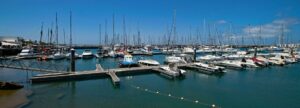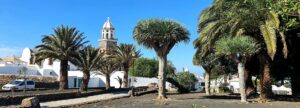The new island capital
Until it was replaced by Arrecife in 1852, the inland city of Teguise was the capital of the Canary Island of Lanzarote. Today Arrecife is one of the seven municipalities on the island and has more than 55.000 inhabitants - about half of all Lanzaroteños.
The history of the city is much more interesting than its architecture:
Arrecife was first mentioned as a small fishing village in the 15th century. The name of the city goes back to the Arrecifes, the black volcanic reefs behind which boats could hide from pirate raids.
Arrecife's growth began towards the end of the 16th century: the increasing port workers and employees needed houses and warehouses had to be built for trade between the Old and New Worlds. As a result, the place became a sought-after pirate destination. In 1571 the pirate Dogan looted and almost completely destroyed the port town.
The Castillo de San Gabriel, built a few years later on the offshore, small island of Islote de Fermina, promised a high level of protection against pirate attacks. But as early as 1586 the pirate Morato Arraez landed in the city and practically wiped it out. In doing so, he destroyed the first fortress built in 1574 at this point. On behalf of the Spanish King Philip II of Spain, today's Castillo de San Gabriel - with a bell tower and sentry box - was built around 1590 according to plans by Leonardo Torriani. It is located directly on the beach promenade and can be reached via a bridge. Today the building houses a museum with an archaeological collection.
The pedestrian zone Leon y Castillo with its many shops is exactly opposite. The Castillo de San José is located a little north of the castle on the Cueva de Inés peninsula, eight meters above the cliff. The building was started by King Charles III. initiated by Spain in 1776. It is also called Hungerburg by the locals because the population suffered from hunger after the massive volcanic eruptions on the island in the middle of the 18th century. According to plans by the civil engineer Alfonso Ochando, this building was also supposed to protect the island from pirate attacks. But since these did not materialize, the Hungerburg lost its importance.
The artist and environmentalist César Manrique (1919–1992) transformed the Castillo de San José into the house of the Museum of Contemporary Art (Museo Internacional de Arte Contemporáneo) in 1974. The museum has a restaurant with a panoramic view of the sea and a large concert hall. Today the gallery shows works by important Spanish artists, such as Joan Miró and Manolo Millares, Óscar Domínguez and of course Manrique himself.
With its three-aisled interior and carved wood ceiling, the Iglesia de San Ginés - the oldest church on Lanzarote - on the Plaza de las Palmas is an interesting destination. A walk on the nearby, inner-city lake Charco San Gines is also recommended.
A special tip is the café in the new Gran Hotel Arrecife on the top floor. Enjoy your coffee with a wonderful view over (almost) all of Lanzarote.






